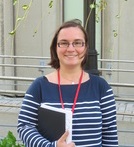Specialized iNANO Lecture: Multidrug Resistance Related Trans-Membrane-Pumps Investigated by Scanning Electrochemical Microscopy
Sabine Kuss, PhD candidate, Laboratory of Electrochemical Reactive Imaging for Biological Systems, McGill University, Chemistry Department, Montreal, Canada
Info about event
Time
Location
Teaching room 1593-222, iNANO House, Gustav Wieds Vej 14, 8000 Aarhus C

Sabine Kuss, PhD candidate, Laboratory of Electrochemical Reactive Imaging for Biological Systems, McGill University, Chemistry Department, Montreal, CanadaMultidrug Resistance Related Trans-Membrane-Pumps Investigated byScanning Electrochemical MicroscopyThe transport of molecules across cell membranes is one of the most fascinating and important features a living cell needs to display in order to thrive and prosper or even just to survive. One of the main mechanisms to actively transport specific substances across membranes of living cells are Adenosine 5ʹ-triphosphate (ATP) -driven Pumps (ABC-transporter). Mutations of genes associated with ABC- transporters lead to severe consequences, such as the development of cystic fibrosis [1] or multidrug resistance [2]. A multidrug resistant cell is able to expel pharmaceutical products from the cytosol, resulting in a resistance against cytotoxic substances used to treat severe diseases, such as cancer. In my research, I am focusing specifically on the Multidrug Resistance Associated Protein 1 (MRP1), which expression level is strongly predictive of the survival rate of cancer patients [3] and plays an important role in childhood cancer relapse [4]. The technique of Scanning Electrochemical Microscopy (SECM) allows the detection of molecules exported from living cells non-invasively. Monitoring the MRP1 activity on the single cell level in human adenocarcinoma cervical cancer (HeLa) cells and an MRP1 over expressing variant is presented. Furthermore, a cell’s electrochemical response to chemical stress was investigated and the resulting establishment of a method to quantify MRP1 expression in living cells will be explained.
| |
| Host: Associate professor Duncan Sutherland, Interdisciplinary Nanoscience Center, Aarhus University |
